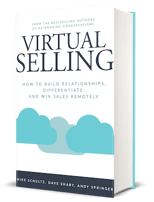Note: You can download this article as a PDF to save it for later!
Developing relationships, collaborating online, leading virtual sales conversations, gaining and keeping attention, leveraging technology, making the ROI case, delivering value—these are hard to do regardless of the sales and economic environment.
But, do these become more difficult when selling virtually versus face-to-face? Are some areas more difficult for sellers than others? What influences buyers’ purchase decisions when buying virtually?
To find out, we conducted a global study of 528 buyers and sellers across the Americas, EMEA, and APAC. We share our findings in this article.
Keep reading for data on where sellers are succeeding and failing in a virtual sales landscape.
Selling in the New Normal
Sales organizations are conducting more of their sales activities virtually.
Only 27% of respondents reported conducting more than half of their sales activities virtually pre-pandemic. Now, 71% conduct more than half their sales virtually—a 163% increase.
According to studies by firms like Bain and McKinsey, virtual selling will continue to be the new normal even when face-to-face is an option. Virtual selling is here—and here to stay.
Virtual Selling Pre- and During Global Pandemic
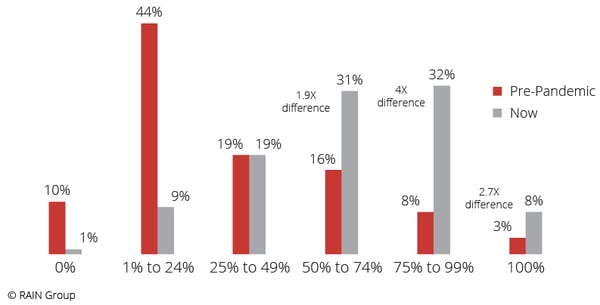
Negative Impact on Sales
The global pandemic has overwhelmingly had a negative impact on sales. Only 11% of respondents reported a positive impact, while 79% reported a negative impact and 10% remained neutral.
With economic uncertainty across the globe, organizations scaled back, adjusted projections, instituted layoffs and furloughs, and froze budgets and spend. One survey participant shared, “Buyers seem to be anticipating and discussing, but not making decisions.” Others also referenced recurring themes of budget cuts and financial restraints.
We’re in a challenging purchasing environment requiring sellers to be better than ever. At the same time, many sellers have had to completely change their sales approach. In most cases, they can no longer meet with buyers face-to-face, creating a very different—and sometimes difficult—buyer/seller dynamic.
We don’t see these challenges going away anytime soon.
There are sales to be made, however, and they’re either going to be made by you or your competitors.
If you want to succeed when selling virtually, you must address these challenges head on and attend to the factors that most influence buyers’ purchase decisions. The sellers who do will be well ahead of the pack.
Impact of Global Pandemic on Sales

Top Virtual Selling Challenges
Of the 18 challenges we studied, the majority of sellers (>62%) rate each one of them as at least somewhat challenging. Even 62% of sellers find the lowest ranked factor—dealing with distractions working from home—challenging.
Sellers described their challenges in the following ways:
- “Changing the feel of sales calls to be less awkward virtually.”
- “Not being able to meet for coffee and then uncover need.”
- “Technical competency of sellers and buyers.”
- “Gauging the temperature of a customer, how they’re feeling towards your opportunity/teams. These are the things you’d pick up on in the office or walking around the corridors.”
- “No emotional/behavioral reaction…it’s like a play with a wall since the buyer is protected behind the screen.”
To succeed with virtual selling, sellers must overcome these challenges and excel in each area. From keeping buyers engaged during virtual meetings and leading a virtual needs discovery to educating buyers with new ideas, negotiating, and using technology and tools, sellers must be better than ever.
Virtual Selling Challenges
Very/Somewhat Challenging for Sellers
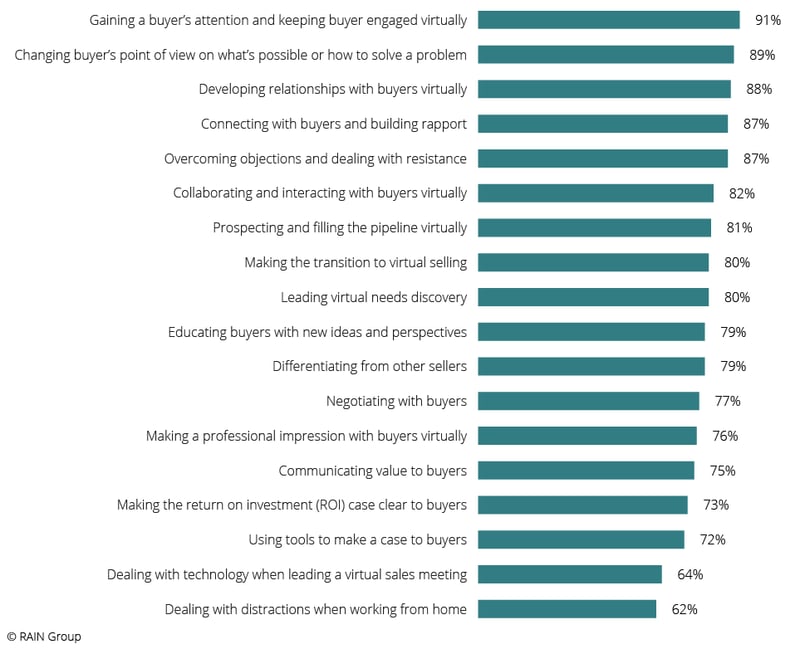
Top 2 Virtual Selling Challenges
The top challenge sellers report facing is gaining buyers’ attention and keeping buyers engaged virtually. It’s much easier to lose a buyer's attention in a virtual setting and much harder to get it back.
Using tools and dealing with technology when leading a virtual sales meeting rank much lower on the challenges list (16-17 of 18 challenges studied), which is good because using technology and tools effectively is a good way to keep buyers’ attention and engagement. It’s not only about using technology, but also leveraging it to its fullest capability to maximize collaboration.
Changing buyers’ points of view on what’s possible or how to a solve a problem is the second highest ranked challenge. This is the crux of advanced consultative selling—what we refer to as insight selling. Sellers change points of view by educating buyers with new ideas and perspectives, but also by pushing back when buyers should be thinking differently.
Virtual Selling Challenges
Very/Somewhat Challenging for Sellers

The Challenge of Developing Relationships with Buyers Virtually
The next two challenges relate to relationships: developing relationships virtually (88% find this challenging) and connecting with buyers and building rapport (87%).
Developing relationships online is much different than in person. There aren’t natural breaks or side conversations. You don’t meet for coffee or lunch before or after your meetings. There’s less time for personal check ins and “getting to know you.”
In virtual meetings, you must create time and space for building rapport. You must be much more proactive and deliberate in your relationship-building efforts. Leave time at the beginning of your meetings for a personal check in. Reach out more frequently to buyers and reference non-business topics you’ve discussed in your meetings: children, hobbies, sports, world events, etc.
Turn your video on during meetings—and make sure to tell buyers ahead of time—as seeing you helps build trust and rapport.
It takes some getting used to and some adjustments, but it’s possible to develop deep, strong relationships virtually.
Virtual Selling Challenges
Very/Somewhat Challenging for Sellers

Top Factors that Influence Virtual Purchase Decisions
While many factors go into purchase decisions, we asked buyers:
When interacting with sellers virtually, what factors have the greatest influence on your purchase decision?
The most influential factor is leading a thorough discovery of buyers’ concerns, wants, and needs (71% rate this as highly influential). This confirms previous buyer research we conducted where we found sales winners demonstrate they understand buyer needs 2.5 times more often than second-place finishers.
Sixty-eight percent of buyers report being highly influenced by sellers who show them what’s possible or how to solve a problem, which was ranked as the #2 top challenge for sellers.
Buyers are also highly influenced by sellers who listen to them (68%). It’s surprising this is a top factor given that the sales industry has been talking about the importance listening since Death of a Salesman in 1949. Unfortunately, sellers still do a very poor job of listening.
Other highly influential factors include making a clear ROI case (66%), educating buyers with new ideas (64%), communicating value (60%), and building relationships (54%), which is also a top challenge for sellers in the virtual environment.
High Influence on Buyer Purchase Decisions
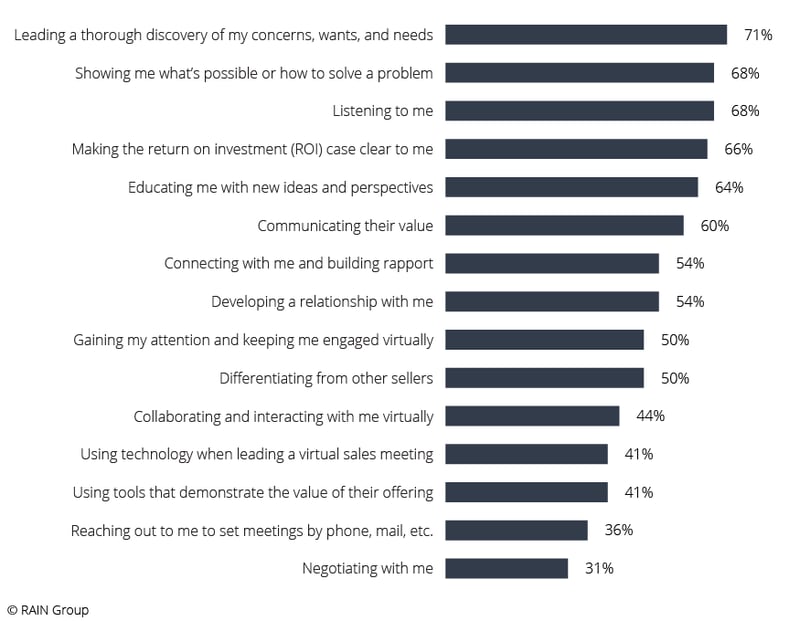
Virtual Seller Effectiveness
We found huge skill gaps when we looked at how sellers perform across the factors that influence buyers' purchase decisions.
Sellers do a poor job in the areas that most influence buyer decisions. Refer to the top four most influential factors above. Sellers are lagging in each:
- 26% of buyers believe sellers are skilled at leading a thorough needs discovery virtually.
- 34% of buyers report that sellers are skilled at showing them what’s possible or how to solve a problem.
- 26% of buyers say sellers are competent listeners.
- 16% of buyers say sellers are very effective at making the ROI case when selling virtually.
To this last point, of the 18 challenges presented, sellers consider making the ROI case one of the least challenging (15th out of 18), yet buyers think sellers are bad at it.
The sad truth? Only two or three in 10 sellers do well in the four areas that most influence purchase decisions.
Consider, as well, that these skills aren’t mutually exclusive.
A seller can’t run an effective needs discovery if they’re not listening. If sellers don’t share what’s possible and don’t uncover the full set of buyer needs, they won’t build as strong an ROI case.
Those sellers who listen to buyers, expand their thinking, show what’s possible, and clearly demonstrate the ROI have a much better chance of succeeding—both virtually and in person.
Top Purchase Decision Factors and Seller Effectiveness
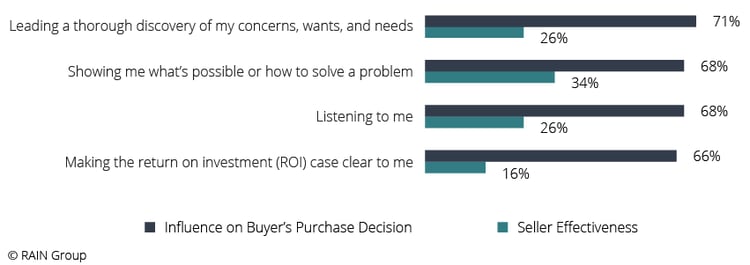
Sellers Lack Virtual Selling Skills Across the Board
Let’s take a look at the whole list. Other large skill gaps appear across the following factors:
- Differentiating themselves from other sellers (only 21% of buyers say sellers are very effective)
- Only 23% of buyers report that sellers are very effective at gaining attention and keeping buyers engaged virtually
- 25% of buyers say sellers are very effective at developing relationships, while more than half of buyers are highly influenced by relationships
According to buyers, sellers are ineffective across the board when it comes to their virtual selling skills.
Top Purchase Decision Factors and Seller Effectiveness
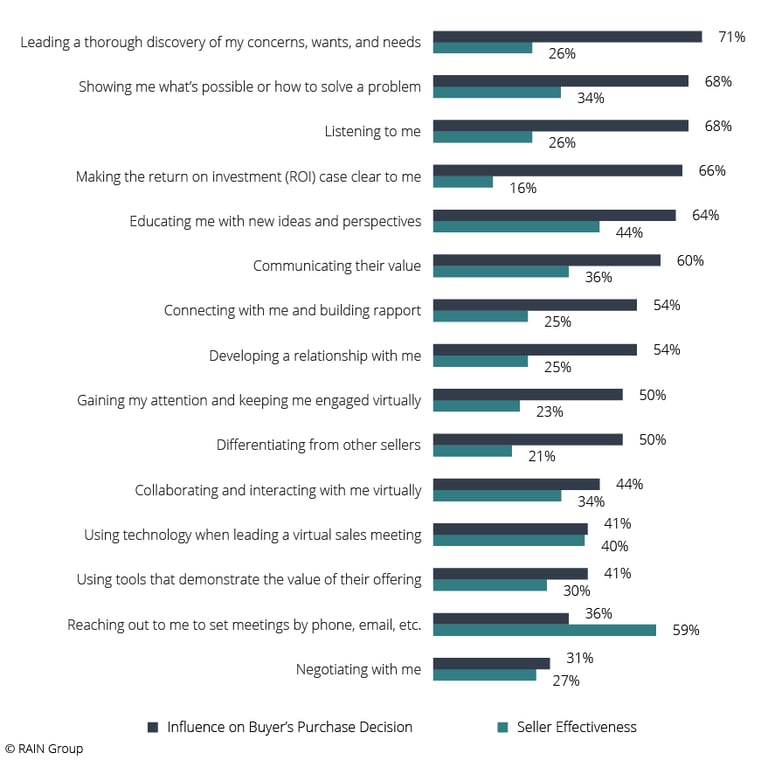
|
Looking to boost your skills in these areas? Check out these resources:
|
The Effect of Lack of Virtual Selling Skills
Even though the top four skills on the list are critical, sellers can’t focus on them to the exclusion of the others. When sellers are poor at the skills listed, buyers largely have negative experiences.
| Selling Skill | What Buyers Experience When Sellers Lack Skills |
| Leading a thorough needs discovery | "They want to sell me that, but a) I don't need it, b) they don't 'get it,' and c) I don't want to work with people who don't focus enough on me." |
| Showing what's possible or how to solve a problem | "The challenge is clear. The solution? They didn't seem to have the right one/it didn't make sense to me." |
| Listening | "I don't want to work with them." |
| Making the ROI case clear | "I didn't see it was worth the investment." |
| Educating with new ideas and perspectives | "I knew all that already. Nothing special here." |
| Communicating value | "Their benefits, ROI, and differentiators didn't jump out at me." |
| Connecting and building rapport | "I didn't like them." |
| Gaining attention and engagement virtually | "I don't even remember what we talked about. I was responding to email while they talked." |
| Differentiating from other sellers | "They're the same. Whoever has the lowest price will win." |
| Collaborating and interacting virtually | "I felt pitched at. I felt like they weren't working with me to achieve the best outcome. I don't feel connected with the seller and I'm not compelled to pursue this as a priority." |
| Using virtual technology and tools | "The meeting itself was amateur hour. We need someone more professional." |
| Reaching out to set meetings | "I bought it from someone else." |
| Negotiating | "I bought but got the price way down in the process." |
Top Virtual Seller Mistakes According to Buyers
Finally, over and above how well sellers perform in core skill areas, we wanted to know how often sellers commit obvious mistakes in the eyes of buyers. Below are the top eight mistakes buyers note they experience at least sometimes.
Technology problems, poor visuals, non responsiveness, and lack of preparation have all been experienced by more than eight in 10 buyers.
Top Virtual Selling Mistakes According to Buyers
Experienced at least sometimes by buyers
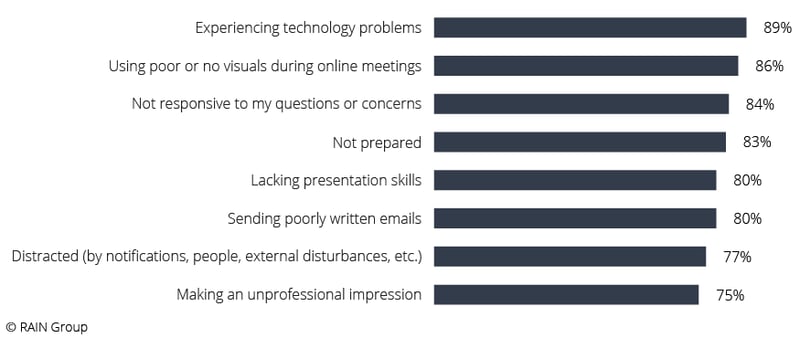
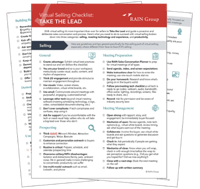
Download the Virtual Selling Checklist to ensure you avoid these mistakes and excel in the three areas essential for virtual selling success: selling, meeting technology and experience, and productivity. |
You Can Succeed with Virtual Selling
Challenges abound when it comes to virtual selling. When you know the challenges, and know which selling skills most influence buyer purchasing behavior, you can adjust accordingly.
Sellers who make these adjustments and master the virtual selling medium are going to be light years ahead of the ones who don’t as we come out of the pandemic.
Download this article as a PDF and share it with your sales teams and colleagues. As you do, think about the challenges you face and how effective you are in the areas that are most important to buyers.
What can you do to improve?
Where do you need to focus?
What help do you need?
Change isn’t easy; it never is.
In the words of General Eric Shinseki, “If you don’t like change, you’ll like irrelevance even less.”
Embrace the change and new norm and you'll succeed in virtual selling.






